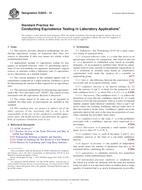Potrebujeme váš súhlas na využitie jednotlivých dát, aby sa vám okrem iného mohli ukazovať informácie týkajúce sa vašich záujmov. Súhlas udelíte kliknutím na tlačidlo „OK“.
ASTM E2935-13
Standard Practice for Conducting Equivalence Testing in Laboratory Applications
Automaticky preložený názov:
Štandardná prax pre vykonávanie Testovanie ekvivalencie v laboratórne aplikácie
NORMA vydaná dňa 1.8.2013
Informácie o norme:
Označenie normy: ASTM E2935-13
Poznámka: NEPLATNÁ
Dátum vydania normy: 1.8.2013
Kód tovaru: NS-46283
Počet strán: 8
Približná hmotnosť: 24 g (0.05 libier)
Krajina: Americká technická norma
Kategória: Technické normy ASTM
Anotácia textu normy ASTM E2935-13 :
Keywords:
bias equivalence, confidence interval, equivalence, equivalence limit, means equivalence, two one-sided t test (TOST), ICS Number Code 03.120.30 (Application of statistical methods)
Doplňujúce informácie
| Significance and Use | ||||||||
|
4.1 Laboratories conducting routine testing have a continuing need to evaluate test result bias, to evaluate changes for improving the test process performance, or to validate the transfer of a test method to a new location or apparatus. In all situations it must be demonstrated that any bias or innovation will have negligible effect on test results for a characteristic of a material. This standard provides statistical methods to confirm that the mean test results from a testing process are equivalent to those from a reference standard or another testing process, where equivalence is defined as agreement within prescribed limits, termed equivalence limits. 4.1.1 The intra-laboratory applications in this practice include, but are not limited to, the following: 4.1.2 This practice also supports
evaluating bias in a method transfer from a developing laboratory
to a receiving laboratory.
4.2 This practice currently deals only with the equivalence of population means. In this standard, a population refers to a hypothetical set of test results arising from a stable testing process that measures a characteristic of a single material. 4.3 The data analysis for
equivalence testing of population means in this practice uses a
statistical methodology termed the “Two one-sided t-test” (TOST)
procedure which shall be described in detail in this standard (see
4.3.1 Historically, this procedure
originated in the pharmaceutical industry for use in bioequivalence
trials 4.3.2 The conventional Student’s
4.4 This practice provides
recommendations for the design of an equivalence experiment, and
two basic designs are discussed. Guidance is provided for
determining the amount of data required to control the risks of
making the wrong decision in accepting or rejecting equivalence
(see 4.4.1 The consumer’s risk is the
probability of accepting equivalence when the actual bias or
difference in means is equal to the equivalence limit. This
probability is controlled to a low level so that accepting
equivalence gives a high degree of assurance that differences in
question are less than the equivalence limit.
4.4.2 The producer’s risk is the risk of falsely rejecting equivalence. If improvements are rejected this can lead to opportunity losses to the company and its laboratories (the producers) or cause additional unnecessary effort in improving the testing process. |
||||||||
| 1. Scope | ||||||||
|
1.1 This practice provides statistical methodology for conducting equivalence testing on numerical data from two sources to determine if their true means are similar within predetermined limits. 1.2 Applications include 1.3 The current guidance in this standard applies only to experiments conducted on a single material. Guidance is given for determining the amount of data required for an equivalence trial. 1.4 The statistical methodology for determining equivalence used is the “Two one-sided t-test” (TOST). The control of risks associated with the equivalence decision is discussed. 1.5 The values stated in SI units are to be regarded as standard. No other units of measurement are included in this standard. 1.6 This standard does not purport to address all of the safety concerns, if any, associated with its use. It is the responsibility of the user of this standard to establish appropriate safety and health practices and determine the applicability of regulatory limitations prior to use. |
||||||||
| 2. Referenced Documents | ||||||||
|
Odporúčame:
Aktualizácia zákonov
Chcete mať istotu o platnosti využívaných predpisov?
Ponúkame Vám riešenie, aby ste mohli používať stále platné (aktuálne) legislatívne predpisy
Chcete vedieť viac informácií ? Pozrite sa na túto stránku.




 Cookies
Cookies
